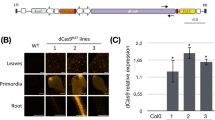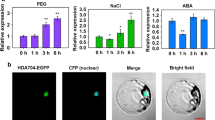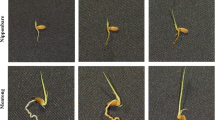Abstract
Key message
We found a histone variant enhances drought tolerance partially via promoting stomatal closure other than osmotic stress resistance, indicating the crucial and complicated contribution of epigenetic regulation to abiotic stress response.
Abstract
Histone variants epigenetically regulate gene transcription through remodeling chromatin. They have been implicated in modulating plant abiotic stress response, however, the role(s) is not well documented. Here, we identified an abiotic stress responsive H2A variant gene TaH2A.7 from wheat. TaH2A.7 shared high identity with H2A homologs and localized to the nucleus. TaH2A.7 overexpression in Arabidopsis significantly enhanced drought tolerance, but had no effect on the response to saline, osmotic and oxidative stresses. TaH2A.7 lowered water loss rate, and promoted ABA-induced stomatal closure. In TaH2A.7 overexpression plants, the mRNA levels of numerous genes involved in the ABA pathway and stomatal movement signaling pathway were elevated, H2O2 level in guard cells was increased, as well. Together, TaH2A.7 can enhance drought tolerance via, at least in part, promoting stomatal closure, and appears to be a promising target for molecular breeding.






Similar content being viewed by others
References
Abe H, Urao T, Ito T, Seki M, Shinozaki K, Yamaguchi-Shinozaki K (2003) Arabidopsis AtMYC2 (bHLH) and AtMYB2 (MYB) function as transcriptional activators in abscisic acid signaling. Plant Cell 15:63–78
Bradford MM (1976) A rapid and sensitive method for the quantitation of microgram quantities of protein utilizing the principle of protein-dye binding. Anal Biochem 72:248–254
Clough SJ, Bent AF (1998) Floral dip: a simplified method for Agrobacterium-mediated transformation of Arabidopsis thaliana. Plant J 16:735–743
Deal RB, Topp CN, McKinney EC, Meagher RB (2007) Repression of flowering in Arabidopsis requires activation of FLOWERING LOCUS C expression by the histone variant H2A.Z. Plant Cell 19:74–83
Grace SC, Logan BA (1996) Acclimation of foliar antioxidant systems to growth irradiance in three broad-leaved evergreen species. Plant Physiol 112:1631–1640
Guillemette B, Gaudreau L (2006) Reuniting the contrasting functions of H2A.Z. Biochem Cell Biol 84:528–535
Henikoff S, Ahmad K (2005) Assembly of variant histones into chromatin. Ann Rev Cell Dev Biol 21:133–153
Huang X, Madan A (1999) CAP3: a DNA sequence assembly program. Genome Res 9:868–877
Jenks MA, Hasegawa PM, Chinnusamy V, Dalal M, Zhu JK (2014) Epigenetic regulation of abiotic stress responses in plants. Jenks MA, Hasegawa PM (eds) Plant abiotic stress, 2nd edn. Wiley, pp 203–229
Kamakaka RT, Biggins S (2005) Histone variants: deviants? Genes Dev 19:295–316
Kim TH, Böhmer M, Hu H, Nishimura N, Schroeder JI (2010) Guard cell signal transduction network: advances in understanding abscisic acid, CO2 and Ca2+ signaling. Ann Rev Plant Biol 61:561–591
Kumar SV, Wigge PA (2010) H2A.Z-containing nucleosomes mediate the thermosensory response in arabidopsis. Cell 140:136–147
Kumar S, Tamura K, Nei M (2004) MEGA3: integrated software for molecular evolutionary genetics analysis and sequence alignment Brief. Bioinformatics 5:150–163
Kwak JM et al (2003) NADPH oxidase AtrbohD and AtrbohF genes function in ROS-dependent ABA signaling in Arabidopsis. EMBO J 22:2623–2633
Larkin MA et al (2007) Clustal W and Clustal X version 2.0. Bioinformatics 23:2947–2948
Liu C, Li S, Wang M, Xia GM (2012) A transcriptomic analysis reveals the nature of salinity tolerance of a wheat introgression line. Plant Mol Biol 78:159–169
Livak KJ, Schmittgen TD (2001) Analysis of relative gene expression data using real-time quantitative PCR and the 2−ΔΔCT Method. Methods 25:402–408
Mittler R (2002) Oxidative stress, antioxidants and stress tolerance. Trends Plant Sci 7:405–410
Munemasa S, Mori IC, Murata Y (2011) Methyl jasmonate signaling and signal crosstalk between methyl jasmonate and abscisic acid in guard cells. Plant Signal Behav 6:939–941
Pei ZM, Kuchitsu K, Ward JM, Schwarz M, Schroeder JI (1997) Differential abscisic acid regulation of guard cell slow anion channels in Arabidopsis wild-type and abi1 and abi2 mutants. Plant Cell 9:409–423
Pei ZM et al (2000) Calcium channels activated by hydrogen peroxide mediate abscisic acid signaling in guard cells. Nature 406:731–734
Peng Z, Wang M, Li F, Lv H, Li C, Xia G (2009) A proteomic study of the response to salinity and drought stress in an introgression strain of bread wheat. Mol Cell Proteom 8:2676–2686
Scippa GS, Michele MD, Onelli E, Patrignani G, Chiatante D, Bray EA (2004) The histone-like protein H1-S and the response of tomato leaves to water deficit. J Exp Bot 55:99–109
Smith AP, Jain A, Deal RB, Nagarajan VK, Poling MD, Raghothama KG, Meagher RB (2010) Histone H2A.Z regulates the expression of several classes of phosphate starvation response genes but not as a transcriptional activator. Plant Physiol 152:217–225
Song Y, Seol JH, Yang JH, Kim HJ, Han JW, Youn HD, Cho EJ (2013) Dissecting the roles of the histone chaperones reveals the evolutionary conserved mechanism of transcription-coupled deposition of H3.3. Nucleic Acids Res 41:5199–5209
Tachiwana H, Osakabe A, Kimura H, Kurumizaka H (2008) Nucleosome formation with the testis-specific histone H3 variant, H3t, by human nucleosome assembly proteins in vitro. Nucleic Acids Res 36:2208–2218
Talbert PB, Henikoff S (2010) Histone variants—ancient wrap artists of the epigenome. Nat Rev Mol Cell Biol 11:264–275
Wang W, Vinocur B, Altman A (2003) Plant responses to drought, salinity and extreme temperatures: towards genetic engineering for stress tolerance. Planta 218:1–14
Wang MC, Peng ZY, Li CL, Li F, Liu C, Xia GM (2008) Proteomic analysis on a high salt tolerance introgression strain of Triticum aestivum/Thinopyrum ponticum. Proteomics 8:1470–1489
Wang M, Liu C, Xing T, Wang Y, Xia G (2015) Asymmetric somatic hybridization induces point mutations and indels in wheat. BMC Genom 16:807
Xia G (2009) Progress of chromosome engineering mediated by asymmetric somatic hybridization. J Genet Genom 36:547–556
Xia GM, Xiang FN, Zhou AF, Wang H, Chen HM (2003) Asymmetric somatic hybridization between wheat (Triticum aestivum L.) and Agropyron elongatum (Host) Nevishi. Theor Appl Genet 107:299–305
Yelagandula R et al (2014) The histone variant H2A.W defines heterochromatin and promotes chromatin condensation in Arabidopsis. Cell 158:98–109
Zhu Y, Dong A, Shen WH (2012) Histone variants and chromatin assembly in plant abiotic stress responses. Biochimica et Biophysica Acta (BBA) Gene Regul Mech 1819:343–348
Acknowledgments
This research was supported by the Natural Science Foundation of China (31171175, 31570258), and the National Transgenic Project (2014ZX08002002-003). We grateful to Dr Jian Ding at Harvard Medical School and Gavinda Sangha at Magdalen College Oxford for the writing improvement.
Author information
Authors and Affiliations
Corresponding author
Ethics declarations
Conflict of interest
The authors declare that they have no conflict of interest.
Additional information
Communicated by Pedro Puigdomenech.
Electronic supplementary material
Below is the link to the electronic supplementary material.
Rights and permissions
About this article
Cite this article
Xu, W., Li, Y., Cheng, Z. et al. A wheat histone variant gene TaH2A.7 enhances drought tolerance and promotes stomatal closure in Arabidopsis. Plant Cell Rep 35, 1853–1862 (2016). https://doi.org/10.1007/s00299-016-1999-6
Received:
Accepted:
Published:
Issue Date:
DOI: https://doi.org/10.1007/s00299-016-1999-6




